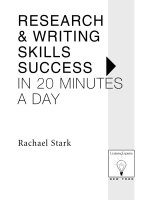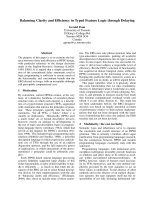Workplace Writing Skills Developing Clarity and Accuracy A Resource to Supplement Existing Published Materials doc
Bạn đang xem bản rút gọn của tài liệu. Xem và tải ngay bản đầy đủ của tài liệu tại đây (965.83 KB, 52 trang )
Workplace
Writing Skills
Developing
Clarity and Accuracy
A Resource to Supplement Existing Published Materials
Christine Polk
Workplace Coordinator and Instructor
South Berkshire Educational Collaborative,
662 Stockbridge Rd. Gt. Barrington, MA 01230
© Christine Polk, 2009
Permission is given for this resource to be copied for use with students.
Funded by the Massachusetts Department of Elementary and Secondary Education
This is a blank page for copying the whole document back-to-back.
Christine Polk, South Berkshire Educational Collaborative, 01230
Contents
Introduction - 1 -
Instructional Handouts and Worksheets
Writing Characteristics
Speaking vs. Writing - 3 -
Guidelines for Appropriate Tone - 4 -
Function, Form, Style, Tone - 6 -
Organizing Lists - 7 -
Different Types of Writing
Complaint
To Another Business - 8 -
Complaint about a Product - 9 -
Response to a Complaint – Not at Fault - 11 -
Response to a Complaint – Apology - 12 -
Response to Requests for Information and/or Opinion
Practice - 13 -
Practice 3 Verb Tenses - 14 -
Record of Spoken Ideas
Talking Topics - 15 -
Record of Your Spoken Ideas - 16 -
Record of a Speech - 17 -
Minutes of a Meeting - 18 -
Proposal
Guidelines - 19 -
Outline a Proposal - 20 -
Practice - 21 -
Effective Words
Transitional Words and Phrases
Examples 22
To Add to the Same Idea 23
To Show Importance 24
To Show Direct Contrast 25
To Show an Unexpected Result 26
To Show Cause and Effect 27
Direct/Less Direct Language
Examples 28
Practice Less Direct Language – Editing 29
Practice Less Direct Language 30
Practice with Proposals 31
Discussion 32
Christine Polk, South Berkshire Educational Collaborative, 01230
Grammar
Sentence Structure
No “fragments” 33
No “run-on” sentences 34
Verbs
6 Verb Tenses Chart 35
Parallel Verb Form – Practice 36
Simple Present Tense – Use 37
Past Tense – Use 38
Verb Tenses – Practice 39
Verb Tenses – Practice and Use 40
Verb Tenses – Use 41
Spelling
Learn to Spell Difficult Words 42
Improve Your Spelling 43
Assessment of Instruction
Writing Checklist 44
Student Feedback 45
Self-Assessment OF Improvement 46
Curriculum Resources
Useful Websites 47
Bibliography 48
Christine Polk, South Berkshire Educational Collaborative, 01230 pg. 1
Introduction
What does this resource contain?
This is not a curriculum that encompasses all the materials needed for a course on effective workplace
writing skills. Rather, it focuses on structured writing practice using the participants’ own workplace
vocabulary. The specific targeted skills are only part of a comprehensive curriculum.
This resource DOES NOT contain the needed exercises, examples and models; many other necessary
skills; or the vital reference lists of grammar, spelling, punctuation, etc. These are not included because
either my class did not need them, or I could easily find them in currently published resources.
What this resource DOES contain is:
Instructional Handouts and Worksheets:
“Writing Characteristics” provides basic awareness about writing;
“Different Types of Writing” provides practice with some specific types of writing that are used
in the workplace;
“Effective Words” focuses on the nuances of workplace language;
“Grammar” focuses on verbs, which often cause the most difficulty;
“Spelling” includes strategies to help learners improve their spelling.
“Assessment of Instruction” – examples for instructors, learners, and managers
“Curriculum Resources” – lists of both internet and print.
Why are Workplace Writing Skills important?
Businesses and organizations rely on efficient and effective written communication.
E-mail is the most common way to communicate in the workplace. Yet, it is very difficult to write
effective, clear e-mails with too little time and too many to read and respond to.
Employees do not know how to write effectively for the workplace. They are intimidated and frustrated.
Misunderstandings occur. Much time is lost in writing and trying to read unclear communications.
Effective workplace writing skills need to be intentionally taught, practiced, reinforced, and valued.
Why did I develop this resource?
I developed this resource when I was teaching Workplace Writing Skills to a group of bi-lingual
supervisors at Kripalu, Center for Yoga and Health, Stockbridge, MA. This was
funded by the Massachusetts Department of Elementary and Secondary Education with a Workplace
Education Grant.
The contents are based on the writing skills that the participants needed to learn and practice. I found
that existing published curriculum did not provide the contextualized structured writing practice to
reinforce the specific skills.
Christine Polk, South Berkshire Educational Collaborative, 01230 pg. 2
I am posting this resource on the web-site so it will be useful to other instructors. The success of these
materials is demonstrated by the comments of the managers that they have seen “amazing”
improvement in the clarity and accuracy of inter-departmental e-mails by the participants. The
participants themselves have noticed that they are much more confident and efficient in their writing
and that they make noticeably fewer mistakes.
Who is this resource for?
This resource is designed to be used by an instructor: professional, workplace supervisor/manager, or
volunteer, who will work with the learner in a positive and supportive way.
Learners are native English speaking, bi-lingual, intermediate and advanced level ESOL employees who
want to improve their written communication in the workplace
Ideally, learners need an identified “mentor” to provide on-going support, to edit their workplace
communications, and reinforce the skills learned.
How do you use this resource?
This resource is supplementary material to existing curriculum. As such, it is not sequential, and is
designed so that the instructor can pick-and-choose what is relevant.
Parts can be used in the classroom and integrated into a writing lesson.
Parts can be used as a stand-alone writing lesson.
Parts can be used by the learner as a homework assignment, a classroom assignment, or for
additional practice.
assess the learners’ needs and progress throughout the course.
target the specific skills the learners need. Some of those skills are included in this resource.
With each skill, provide:
Examples, samples, models, explanations etc. to teach the skill.
Published business writing and grammar books contain many good examples.
The instructor’s role is to explain the skill or concept and enable the learners to relate it to their
own workplace situation.
Structured practice opportunities to reinforce the skill.
Many of the practice activities in this resource require the learners to use their own language
relevant to their specific workplace needs.
The instructor’s role is to provide supportive correction and guidance.
Encouragement to use the skills learned.
The instructor’s role is to encourage the learners to check their workplace writing for the
correct use of the skills that they have learned, and report the improvement in their writing.
Christine Polk, South Berkshire Educational Collaborative, 01230 pg. 3
Speaking vs. Writing
Writing does not always communicate your meaning.
The reader creates the meaning.
Speaking uses many more communication tools:
Writing has no body language;
has no tone of voice;
has no facial expressions.
Writing has only words.
Be careful what you write.
Be careful with anything that concerns negative emotions.
Practice
E-mail received: I heard at the meeting that you said I was rude to you!
Response: I never said you were rude to me.
Read each sentence below emphasizing the bold word.
Discuss the meaning and implication of each statement.
Add another sentence to clarify the meaning of each.
1. I never said you were rude to me.
2. I never said you were rude to me.
3. I never said you were rude to me.
4. I never said you were rude to me.
5. I never said you were rude to me.
6. I never said you were rude to me.
Christine Polk, South Berkshire Educational Collaborative, 01230 pg. 4
Guidelines for Appropriate Tone
Tone – The attitude of the writer to the subject and audience.
It affects how the reader will perceive the message.
Planning to Write
What is your purpose? What is your intent?
Only write when you have a clear sense of why you are writing.
Who is your audience? What is the best way to reach your reader?
Writing is always an extension of the relationship you have with a person.
Try to visualize the person reading and reacting to your writing.
Presenting the Information
Be Confident
You can feel confident if you have planned, organized, and are knowledgeable about the
material. You want the reader to do as you ask or to accept your decision. If you write
confidently you will be more persuasive.
Be Courteous and Sincere
You can build goodwill for yourself by using a tone that is polite and sincere. Without sincerity,
politeness can sound condescending. If you are respectful and honest, readers will be more
willing to accept your message, even if it is negative.
For example:
Not: You didn't read the instructions carefully, thus your system has shut down.
But: The system may automatically shut down if any installation errors occur.
Write at an Appropriate Level of Difficulty
Write at an appropriate level of difficulty in order to clearly convey your message. Your writing
needs to match the reading abilities of your audience. Do not use complex passages or terms that
the reader will not understand. Conversely do not use simple terms or insufficient examples if the
reader is capable of understanding your writing.
Christine Polk, South Berkshire Educational Collaborative, 01230 pg. 5
Use Nondiscriminatory Language
Nondiscriminatory language is language that expresses equality and respect for all individuals. It
does not use any discriminatory words, remarks, or ideas. Make sure your writing is free of
sexist language and free of bias based on such factors as race, ethnicity, religion, age, sexual
orientation, and disability.
Use gender-neutral language.
Not: Chairman
But: Chairperson
Not: Executives and their wives
But: Executives and their spouses
Not: Dear Gentlemen:
But: To Whom It May Concern:
Not: Each student must provide his own lab jacket.
But: Students must provide their own lab jackets. Or: Each student must provide his or her own
lab jacket.
Avoid demeaning or stereotypical terms.
Not: After the girls in the office receive an order, our office fills it within 24 hours.
But: After the office receives an order, our office fills it within 24 hours.
Omit information about group membership.
Not: Connie Green performed the job well for her age.
But: Connie Green performed the job well.
Stress the Benefits for the Reader
Write from the reader's perspective. Instead of writing from the perspective of what the reader
can do for you, write in a way that shows what you can do for the reader. A reader will often
read a document wondering "What's in it for me?" Stressing reader benefits will help you to
avoid sounding self-centered and uninterested
Not: I am processing your order tomorrow.
But: You will receive your order in two weeks.
Christine Polk, South Berkshire Educational Collaborative, 01230 pg. 6
Function, Form, Style, Tone
Practice
Compare these three e-mails. Think about:
Function – the relationship to the reader and the purpose
Form – the organization, format, construction
Style – the type of writing
Tone – the attitude of the writer
Write a reply to each reflecting the characteristics of each.
Use the course resources including the “Writing Checklist.”
Writing Class Participants,
Just a reminder to bring your pre-course assessment to class on Wednesday, if I have
not got it already.
Also, thank you for emailing me copies of your recent communications. They have helped
me design the course and priorities.
Looking forward to seeing you on Wednesday.
Christine
Hi Everyone, Hope you are having a good week and consciously thinking about your
writing. It was great to be with you last week and get to know you and find out what you
need to improve your writing. The emails you copied me on helped me decide what to
teach you. It’s all going to be very useful and practical. Your standard of writing is very
good – but we need to work on a few things to make it better. By the way, I’m sorry to
bother you about this, but I really need the pre-course assessment. So, consider this a
reminder. If you could give it to me on Wednesday I would really appreciate it. I’m looking
forward to seeing everyone again on Wednesday. We will have binders and handouts
and worksheets to practice the writing skills. It’s going to be wonderful. Thanks, Hugs,
Christine
Writing Class Participant:
I need your pre-course assessment if you have not given it to me.
Bring it to class on Wednesday.
Christine Polk
Instructor
Christine Polk, South Berkshire Educational Collaborative, 01230 pg. 7
Organizing Lists
Lists organize and classify ideas.
Lists make a series of items clear and more convincing.
Lists can be used as a reference to remember/confirm/clarify something previously
said or agreed upon.
Principles
Lists need to contain items of the same classification/category.
For example: conclusions must be separate from recommendations, causes from effects, past
from present, etc.
Lists need to have parallel grammar construction.
They must begin with the same part of speech.
For example: all are sentences, all begin with verbs, etc.
If an item cannot be phrased in a parallel construction, it is probably a different category.
Lists need to be limited to five points per category.
Lists need to be easy to understand and remember.
If there are more than five items, create more categories, or divide the information into smaller
pieces.
Lists need to be organized according to importance or how the items relate to each other.
Lists need to have bullets or numbers.
Practice
Correct the following bulleted list.
Ways to ensure effective writing:
Short sentences are a good idea.
Divide your writing into paragraphs.
Editing your writing before you send it is essential.
You must avoid spelling mistakes.
To check your writing, read it aloud.
Use: Write a list of ways to ensure workplace safety.
Christine Polk, South Berkshire Educational Collaborative, 01230 pg. 8
Complaint
Practice Brainstorm problems you have had with other businesses.
Chose one to write a complaint about.
Follow these guidelines.
Tone
Keep it short.
Focus on the result you want rather than on a person’s or company’s incompetence.
Use whatever tone – light/angry/disappointed/concerned – you think will get results.
But, be tactful. Do not be harshly critical.
1. Opening
If possible say something positive about the company or your relationship.
Introduce your problem.
We have enjoyed a long-standing relationship, but
I am concerned about
I was disturbed to see
Last month we ordered
2. Focus
Explain the problem. Make sure you have all the information about the problem.
Cite the steps, if any, that have been taken to resolve the problem, so far.
State continuing instances of the problem or failure to solve it. (Complaints are often
documented in writing because talking has not worked.)
This is not consistent with
This type of misunderstanding makes it difficult for us.
I was under the impression that we agreed on
My expectation was that
In our previous discussions, we said
3. Action
Tell the company your solution and when you want it implemented.
You could mention acceptable alternatives or ask the reader for some.
What can we do to correct the problem?
What alternatives can you suggest?
When will you know
4. Closing
Mention a specific follow-up step and date.
Be as pleasant and positive as possible.
I want to work with you.
I appreciate your attention to this and I expect
I would like you to
I don’t want to cancel, so
Christine Polk, South Berkshire Educational Collaborative, 01230 pg. 9
Complaint about a Product
Practice Brainstorm problems you have had about products.
Chose one to write a complaint about.
Follow these guidelines.
Goal
To write to the right person who will take responsibility to fix your problem.
You often need to write about a complaint because talking has not worked.
Tone
Keep it short.
Be tactful. Do not be too critical. Be as positive as possible.
1. State your problem
Be as specific with dates, model numbers, descriptions etc.
First sentence
On (date) I ordered/bought/purchased by phone/internet/mail/in your store …
Product problems
Part of the product/order (specify) was missing/broken/damaged.
It is defective/does not work. (How?)
It is very poor quality. (How?)
It is the wrong item/color/size/quantity/style/model.
I am returning the enclosed … because ….
There was no packing slip/directions.
Shipping problems
… arrived/got here/delivered too late/damaged.
Billing problems
The invoice/billing/information is wrong/incorrect.
I was billed too much/for the wrong item.
There is a problem/mistake/an error on my bill/account/invoice.
I cancelled the order on (date) but I have been billed for it.
2. Focus
Why do you need to write?
State the steps that have already taken to resolve the problem.
I have telephoned ___ times. (Give dates and who you spoke to.)
I was told that the item/credit/check will be sent/replaced. It has not arrived.
I left a message on your voice-mail and have had no response.
Your representative could do nothing about this.
The person I talked to could not help me.
Add your opinions if you like.
I am disappointed/concerned/disturbed.
This is obviously unacceptable/unsatisfactory.
Christine Polk, South Berkshire Educational Collaborative, 01230 pg. 10
3. Action
Tell the company your solution and when you want it done.
You could mention acceptable alternatives.
If possible say something positive about the company.
I have been using your business since …. and have always had excellent service.
You were recommended to me by… as an excellent company.
I bought this from you because of your excellent reputation.
Requesting
Please …
I would appreciate if you would …
I would like you to …
I want/expect you to …
You need to …
Action
….replace/exchange it.
….send/give me a credit/refund.
….send me the missing items.
4. Closing
Mention a specific follow-up step and date.
Please write by (date). Please check my address so there is no mistake.
I will expect … by (date)
Please call my phone (number) and leave a message about what you will do and when.
Christine Polk, South Berkshire Educational Collaborative, 01230 pg. 11
Response to a Complaint
when you are Not at Fault
Practice
Brainstorm complaints that you have had.
Chose one to respond to.
Follow these guidelines.
Tone
Maintain a neutral tone and stick to the facts.
Be courteous.
1. Opening
Thank the person for writing about the problem. Acknowledge the person and the feelings. People write
complaints to be heard, to get sympathy, an apology, action, or some financial adjustment.
“I’m sorry” and “I regret” means you did nothing wrong.
“I apologize” means you did do something wrong.
Thank you for your e-mail expressing your disappointment.
I appreciate you letting us know about this.
I understand your frustration.
I regret you had trouble/difficulties.
We regret the misunderstanding/miscommunication about …
We are sorry to hear about …
2. Focus
Relate to the specific problem. Explain why you are not at fault.
Do not suggest that the reader shares the blame, even if s/he does.
Unfortunately this was beyond our control/out of our hands
I’m sorry that we couldn’t do anything about
Our handbook/policy/information says
We were under the impression that
The information you provided indicated
3. Action
Relate to what the reader wants.
I looked into what happened, and I learned that …
Unfortunately I cannot (do whatever the reader wants) but I can …
… is, of course, out of our control.
I will pass your letter on to …….
4. Closing
End on a positive note.
We are committed to/take pride in high-quality customer service.
You are important to us.
We look forward to seeing you again and trust that (mention things from the letter that will
be better.)
Christine Polk, South Berkshire Educational Collaborative, 01230 pg. 12
Response to a Complaint
Apology
Practice Brainstorm complaints that you have had.
Chose one to respond with an apology.
Follow these guidelines.
Tone
Express your regret and concern, but not too much.
Don’t make excuses or offer long explanations.
Sincere apologies can help mend relationships.
1. Opening
Acknowledge the mistake.
We have received your letter of February 19, 2009 about ……
2. Focus
Admit your mistake and accept responsibility for the error: the “pure apology” sentence.
Do not suggest that the customer share the blame (e.g. by suggesting s/he is too sensitive).
Do not blame someone else.
Thank you for notifying us about ….
We are sorry to hear about …
We regret the error ….
I apologize for ….
Rarely happens.
You are correct.
That should not have happened.
I understand your disappointment/frustration.
3. Action
Be clear about the solution, adjustment or compensation (if asked and appropriate).
We will not charge you for …
Enclosed is ….
We are willing to ….
As a token of our regret ….
4. Closing
Try to restore the customer’s faith. You could apologize again.
Explain how you will avoid similar problems in the future.
End on a positive note.
Again, my sincere apology.
We have high standards for …
We are taking steps to ensure that this does not happen again.
We appreciate your business and hope that …
We look forward to seeing you in the future.
You are welcome to call me to discuss this further.
Christine Polk, South Berkshire Educational Collaborative, 01230 pg. 13
Response to a Request
for Information and/or Opinion
Practice
Write a response to this e-mail from your manager.
Department Heads:
In preparation for the managers’ meeting, I want to know your opinion about how the present economic
situation has impacted your job and your department.
1. What challenges have you faced?
2. What changes have you needed to make?
3. What challenges do you see in the future?
4. What can we do to meet these challenges?
5. What is positive about our current situation?
Please respond this week.
Thank you,
Christine
Follow these Guidelines:
Use a bulleted narrative format.
State your most important points early.
Be specific. Give examples.
Make sure you emphasize what a great job you are doing.
Be supportive of the challenges.
State the positive and potentially positive.
Be clear if you want your manager to do something soon.
Christine Polk, South Berkshire Educational Collaborative, 01230 pg. 14
Response to a Request
for Information and/or Opinion
Practicing 3 Different Tenses
Write a response to this e-mail from your manager, (or a manager from an imaginary
company.)
Department Heads:
We are up-dating the information we give to new employees about our company.
We want to know what you think is the most important information to include.
1. What our company is like now: including the values, work environment, expectations
etc.
2. A description of our company’s background and history.
3. What our company will be like in the future.
Please respond this week.
Thank you,
Christine
Follow these Guidelines:
Use a bulleted narrative format.
Be specific. Give examples.
Use the correct verb tense.
Question 1: Simple Present.
Question 2: Simple Past.
Question 3: Simple Future.
Underline each targeted verb tense.
Christine Polk, South Berkshire Educational Collaborative, 01230 pg. 15
Talking Topics
To Use with Practice of:
Record of your Spoken Ideas
Record of a Speech
Minutes of a Meeting
1. What are the major differences between young staff members and older staff
members? How is age significant?
2. What specific ways can you increase workplace safety?
3. Should all employees take first-aid courses, such as CPR?
Why or why not?
4. In the development of the budget, what is more important, higher pay, or better
benefits? Explain.
What further benefits would you like?
5. What are the advantages and disadvantages of a multi-cultural workforce?
6. What can the top administration learn from the staff?
How do you suggest they can learn?
7. What can be done to encourage more and better qualified candidates to apply for
openings?
8. What are the essential characteristics of an effective manager?
9. What advice would you give to new employees?
10. What are the best methods of disciplining staff?
11. CHOOSE YOUR OWN TOPIC.
Christine Polk, South Berkshire Educational Collaborative, 01230 pg. 16
Record of Your Spoken Ideas
Practice
Speak on a topic for about 2 minutes from the “Talking Topics” list.
Write an e-mail in response to:
“Send me an e-mail about the ideas you spoke about.”
Follow these Guidelines.
Include as much about your spoken ideas as you think is appropriate.
Sometimes spontaneous ideas are not suitable for a written record.
Expand and delete according to your later thoughts.
Organize your ideas with bullets.
Prioritize them.
The most important point/idea is ………
………. is less significant
On reflection I do not now think that …….
Include ideas and thoughts you did not speak about, but are important.
Something else to consider is …….
I did not have time to mention ………
Acknowledge the positive interaction.
I’m glad I had the chance to share my ideas with you.
Thank you for asking my opinion.
Mention future plans
If you would like to talk with me more …….
I would be happy to develop these thoughts.
Would you like me to share these ideas with ……
Christine Polk, South Berkshire Educational Collaborative, 01230 pg. 17
Record of a Speech
Practice
Listen to a person speaking about a “Talking Topic.”
Follow these guidelines.
1. Make notes
Write key words or phrases as the speaker talks.
Organize your notes with the main idea and important details.
Add any you missed when the speaker stops.
2. Write the record on a separate piece of paper
Start with an introductory sentence: who spoke about what topic.
Include all the important points. It is a summary of what is said.
Write as a narrative with bullets.
No “value judgments”. Keep your own thoughts out. Just record what was
said.
Write so that if your audience was not present they would understand.
3. Share
Read your “record” to the group.
After you have shared, ask the speaker to clarify anything that is not clear.
4. Reflect
After others have shared, discuss how the versions are the same and
different.
Christine Polk, South Berkshire Educational Collaborative, 01230 pg. 18
Minutes of a Meeting
the record of discussions and decisions.
Practice
Listen to two or more people discussing a “Talking Topic.”
Follow these guidelines.
1. Make notes
Record which person is talking.
Write key words or phrases as the speaker talks.
Organize your notes with the main idea and important details.
Add any you missed when the discussion stops.
2. Write the “Minutes” on a separate piece of paper
Start with an introductory sentence about the topic of the discussion.
Include all the important points. It is a summary of what is said.
Write as a narrative with bullets.
No “value judgments”. Keep your own thoughts out. Just record what was said.
Write so that if your audience was not present they would understand.
3. Share
Read your “Minutes” to the group.
After you have shared, ask the speakers to clarify anything that is not clear.
Christine Polk, South Berkshire Educational Collaborative, 01230 pg. 19
Proposal
Purpose:
To advocate for (make a case for) a certain action, policy, or position.
Guidelines
Think about the reader before you start to write.
How much information does your reader need?
How does your proposal meet the needs/goals of the reader?
Will your reader like your proposal, or need to be persuaded?
Organization (Refer to “Outline a Proposal”)
1. Opening Statement
2. Your Position
3. Issues, Ideas
4. Conclusions
5. Recommendations, Action Plan
6. Closing
Tone
Be confident, but write as a carefully considered idea.
Have a collaborative tone.
Examples of Language to Use
I propose that/recommend that/suggest that
I have an idea for you to consider.
This would enable us to
… will benefit the company by
This will have a significant long-term benefit.
If you are concerned about….then we can
It is important that we be involved because
….will demonstrate our support for
This will enable us to achieve our goal of
Everyone would benefit
This should take care of the problem
I am confident that
I appreciate your consideration and look forward to hearing from you.
Please let me know what you think
Christine Polk, South Berkshire Educational Collaborative, 01230 pg. 20
Outline a Proposal
Make notes – use this page as a template.
Organize your brainstorming ideas.
Use words and phrases, not sentences. Focus on the content.
Use all or some of these ideas in your final proposal.
1. Introduction: Opening Statement
What prompts this proposal? Why are you writing this?
Why is it important?
2. Proposal
What do you want your reader to do? (This is your first sentence of the second paragraph.)
What background information does your reader need?
3. Ideas
After you have listed your ideas, number them in order of importance.
Idea Advantages Disadvantages
4. Conclusion (Based on your most important idea.)
5. Proposal and Action Plan
6. Closing - What specific response would you like?
Christine Polk, South Berkshire Educational Collaborative, 01230 pg. 21
Proposal
Practice
Your manager has asked for your proposals to improve the quality and productivity
in your company.
Respond to one of the following questions. State your reasons for your
answer.
Follow the “Proposal Guidelines.”
Plan before writing. See “Outline a Proposal.”
1. If you could buy one expensive item for your company, what would it be?
2. What are the characteristics of people you would not hire?
How would you find out?
3. What are the characteristics of people you would hire?
How would you find out?
4. How could your company improve the quality of customer service?
5. How would you increase the productivity and efficiency in your company?
Your own idea
6. What would you like to recommend to your supervisor or manager? Write a
proposal.









